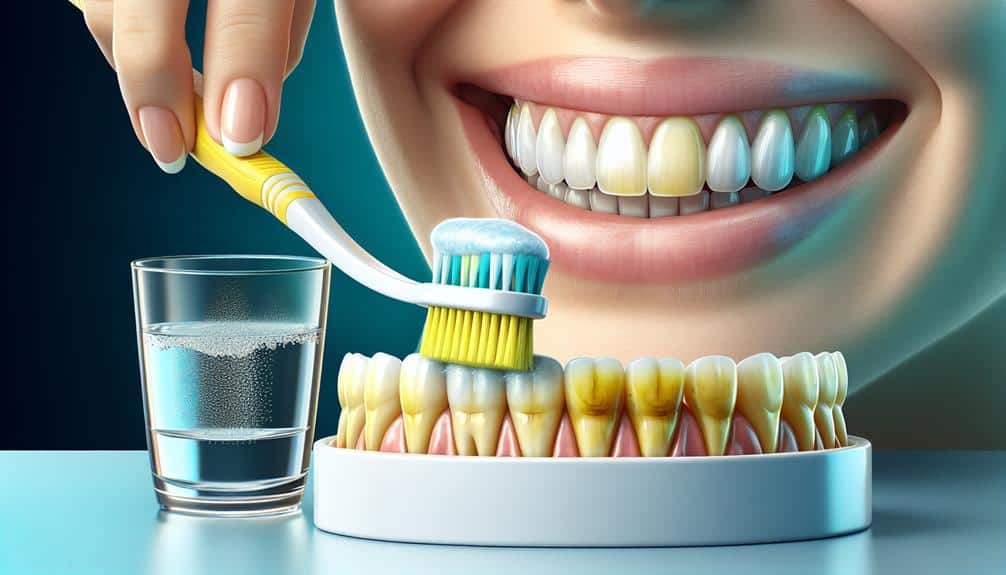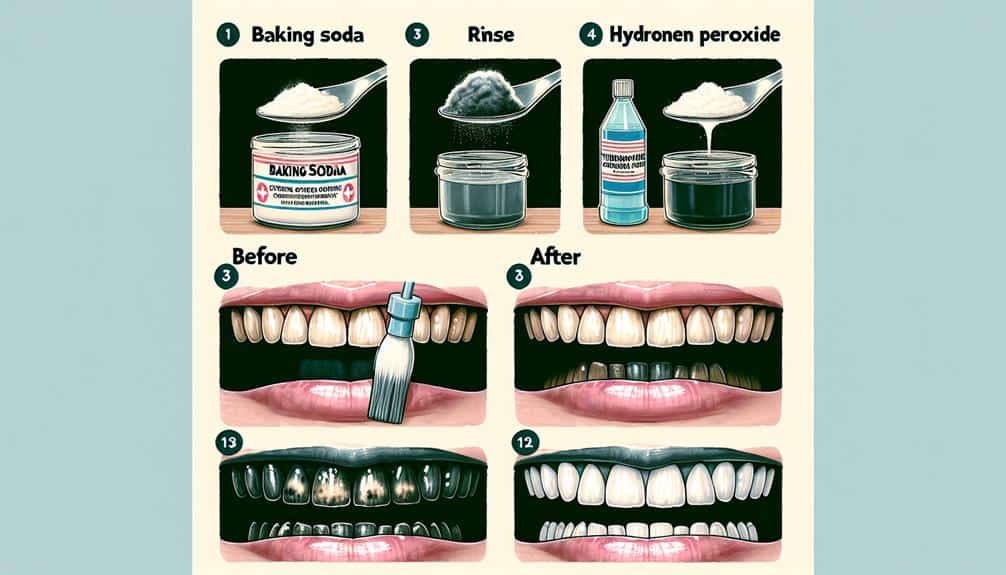For visibly brighter smiles and stubborn intrinsic stains, choose Tetracycline teeth whitening. It offers long-lasting effectiveness over traditional methods. This treatment penetrates enamel and dentin, binding to discoloration-causing molecules. Tackling intrinsic stains directly, it provides a reliable option for enhancing tooth appearance. Professional options tailored to your needs include in-office bleaching or take-home kits. Discussing long-term effects with your dentist guarantees satisfaction. To maintain results, practice consistent oral hygiene and avoid staining foods. Consider exploring the detailed benefits and how Tetracycline whitening works for lasting improvements in smile brightness.
Key Points
- Long-lasting solution for tetracycline stains
- Cost-effective compared to OTC products
- Provides lasting improvement in smile brightness
- Targets intrinsic stains effectively
- Avoids frequent reapplication of less effective treatments
Understanding Tetracycline Stains
To better comprehend the nature of tetracycline stains on teeth, consider that these discolorations result from the interaction of tetracycline antibiotics with developing teeth during childhood. Tetracycline mechanisms involve the incorporation of the antibiotic into the mineral structure of the teeth, leading to discoloration patterns that can range from light yellow to dark brown or grey. These stains are often challenging to treat with conventional whitening methods due to their deep-seated nature.
When exploring alternative treatments for tetracycline stains, cosmetic dentistry offers solutions such as veneers, bonding, or crowns to mask the discoloration effectively. These methods can provide long-lasting results and enhance the appearance of teeth affected by tetracycline stains. It's important to consult with a qualified dentist specializing in cosmetic procedures to determine the most suitable treatment option based on the severity of the stains and individual preferences.
Understanding the underlying mechanisms of tetracycline stains is essential in selecting the appropriate cosmetic dental intervention for restoring the natural brightness of your smile.
Benefits of Tetracycline Teeth Whitening
Tetracycline teeth whitening procedures offer a proven method for effectively reducing and eliminating the stubborn stains caused by tetracycline antibiotics. One of the key benefits of tetracycline teeth whitening is its long-term effectiveness. Unlike some over-the-counter whitening products that may provide temporary results, tetracycline teeth whitening can deliver lasting improvements in the brightness of your smile. This long-lasting effect is particularly advantageous for individuals seeking a more permanent solution to tetracycline stains.
Moreover, when considering teeth whitening options, cost is an important factor for many individuals. Tetracycline teeth whitening can be a cost-effective solution in the long run. While initial costs may be higher compared to certain store-bought whitening kits, the durability of the results can make it a more economical choice over time. By investing in tetracycline teeth whitening, you aren't only achieving a brighter smile but also potentially saving money by avoiding frequent reapplication of less effective treatments.
How Tetracycline Whitening Works
When seeking to understand how tetracycline whitening works, it's essential to grasp the mechanism behind its stain-reducing properties. Tetracycline works by penetrating the enamel and dentin of the teeth, targeting and breaking down the molecules that cause discoloration. The mechanism involves the tetracycline molecules binding to the chromophores responsible for the stains, which then alters the structure of these molecules, making them less visible. This process effectively reduces the appearance of stains, leading to a brighter smile.
The effectiveness of tetracycline whitening lies in its ability to address intrinsic stains caused by factors like tetracycline antibiotics. While extrinsic stains sit on the surface of the teeth and can often be removed with regular cleaning, intrinsic stains are embedded within the tooth structure and require a more targeted approach. Tetracycline whitening's mechanism of action directly tackles these stubborn intrinsic stains, making it a reliable option for those seeking to improve the appearance of their teeth.
Professional Tetracycline Whitening Options
Considering the range of professional tetracycline whitening options available, you can explore tailored treatments to effectively address intrinsic stains and enhance your smile brightness. When seeking professional tetracycline whitening, it's important to compare alternative treatments like in-office bleaching or take-home kits to determine the most suitable option based on your needs and budget. While in-office treatments may offer quicker results, take-home kits provide convenience and cost-effectiveness.
Discussing long-term effects with your dentist is vital to make sure the chosen treatment aligns with your expectations. Patient satisfaction plays a significant role in determining the success of tetracycline whitening procedures. It's crucial to communicate openly with your dental provider to achieve the desired results and maintain them over time. By weighing the cost comparison and understanding the potential long-term effects on your teeth, you can make an informed decision that leads to a brighter, more confident smile.
Maintaining Results After Treatment
To maintain the results achieved after whitening treatment, consistent oral hygiene practices are essential. Long term care is important in preserving the brightness of your teeth post-treatment.
Brushing your teeth at least twice a day with a fluoride toothpaste helps prevent staining and maintains the whiteness of your teeth. Flossing daily is equally significant as it removes plaque and prevents discoloration in between teeth where your toothbrush can't reach. Using a whitening toothpaste can also aid in maintaining the results by gently removing surface stains.
Additionally, regular dental check-ups and professional cleanings every six months are crucial for long term care. Your dentist can identify any early signs of discoloration and provide appropriate treatments to maintain your bright smile.
Avoiding foods and drinks that are known to cause staining, such as coffee, tea, and red wine, can also help in preventing discoloration and preserving the results of your tetracycline teeth whitening treatment.
Frequently Asked Questions
Are There Any Potential Side Effects or Risks Associated With Tetracycline Teeth Whitening?
When contemplating tetracycline teeth whitening, it is crucial to acknowledge potential risks and long-term effects. While generally safe, side effects like tooth sensitivity or gum irritation may occur. Consulting a dentist can help mitigate any concerns.
Can Tetracycline Teeth Whitening Be Used on Children or Teenagers?
Yes, tetracycline teeth whitening can be used on children and teenagers. Pediatric usage and adolescent applications have shown positive results, but it's important to consult a dentist for proper evaluation and guidance before proceeding with treatment.
How Long Does Tetracycline Teeth Whitening Treatment Typically Last?
For most people, tetracycline teeth whitening treatment typically lasts around 1-2 years with proper maintenance. Long term effects can vary, but outcomes often depend on individual habits and oral care routines.
Is Tetracycline Teeth Whitening Suitable for Individuals With Sensitive Teeth?
If you have sensitive teeth, tetracycline teeth whitening may not be the best choice. Consider alternatives for pain management. Long term results and effectiveness can vary. Consulting with a dental professional is essential for personalized advice.
Are There Any Dietary Restrictions or Special Care Instructions to Follow During Tetracycline Teeth Whitening Treatment?
During tetracycline teeth whitening, adhere to dietary restrictions to prevent staining. Rinse after consuming foods like berries or beverages like coffee. Follow care instructions diligently, including regular brushing and flossing, to maintain the whitening effects and overall oral health.



